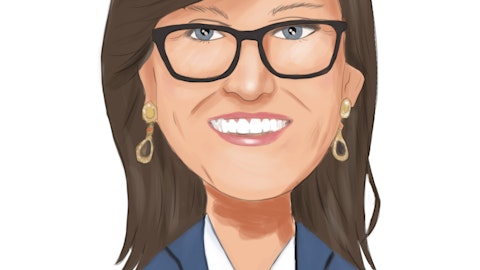Xometry, Inc. (NASDAQ:XMTR) Q4 2023 Earnings Call Transcript February 29, 2024
Xometry, Inc. reports earnings inline with expectations. Reported EPS is $-0.01 EPS, expectations were $-0.01. Xometry, Inc. isn’t one of the 30 most popular stocks among hedge funds at the end of the third quarter (see the details here).
Operator: Hello and thank you for standing by. Welcome to Xometry Q4 and Full Year 2023 Earnings Conference Call. At this time, all participants are in a listen-only mode. After the speaker’s presentation, there will be a question-and-answer session. [Operator Instructions] I would now like to hand the conference over to your speaker, Shawn Milne. You may begin.
Shawn Milne: Good morning and thank you for joining us on Xometry’s Q4 and Full Year 2023 Earnings Call. Joining me are Randy Altschuler, our Chief Executive Officer; and Jim Rallo, our Chief Financial Officer. During today’s call, we will review our financial results for the fourth quarter and full year 2023 and discuss our guidance for the first quarter and full year 2024. During today’s call, we will make forward-looking statements, including statements related to the expected performance of our business, future financial results, strategy, long-term growth and overall future prospects. Such statements may be identified by terms such as believe, expect, intend and may. These statements are subject to risks and uncertainties, which could cause them to differ materially from actual results.
Information concerning those risks is available in our earnings press release distributed before the market opened today and in our filings with the US Securities and Exchange Commission, including our Form 10-K for the year ended December 31st, 2023, that will be filed later today. We caution you not to place undue reliance on forward-looking statements and undertake no duty or obligation to update any forward-looking statements as a result of new information, future events or changes in our expectations. We’d also like to point out that on today’s call, we will report GAAP and non-GAAP results. We use these non-GAAP financial measures internally for financial and operating decision-making purposes and as a means to evaluate period-to-period comparisons.
Non-GAAP financial measures are presented in addition to and not as a substitute or superior to measures of financial performance prepared in accordance with US GAAP. To see the reconciliation of these non-GAAP measures please refer to our earnings press release distributed today and our investor presentation, both of which are available on the Investors section of our website at investors.xometry.com. A replay of today’s call will also be posted on our website. With that, I’d like to turn the call over to Randy.
Randy Altschuler: Thanks, Shawn. Good morning, everyone, and thank you for joining us for our Q4 and full year 2023 earnings call. In Q4, we had the highest revenue in gross profit in Xometry’s history, beating our previous highs from Q3 of 2023. We grew revenue 31% year-over-year to $128 million, driven by accelerating 42% year-over-year growth in Marketplace revenue. Q4 Marketplace gross profit increased 68% year-over-year driven by our AI-powered Marketplace. Q4 Marketplace gross margin improved 500 basis points year-over-year. Overall, in 2023, we delivered 30% Marketplace growth and stronger active buyer and order growth despite an ongoing contraction in US manufacturing. We are gaining significant market share. On top of strong Marketplace revenue and gross profit growth, we improved our operating leverage, reducing our adjusted EBITDA loss in Q4 by 32% from Q3 to $2.9 million, as we continue to balance growth and profitability goals.
On a year-over-year basis, Q4 adjusted EBITDA improved by $12.8 million, driven by significant leverage in our core US Marketplace partly offset by investments internationally. Over the past few years, we have rapidly grown our networks and expanded our Marketplace globally, further strengthening our competitive moat. At the same time, we made significant investments in product development and technology infrastructure and selected acquisitions. We now offer tools to digitize work for both buyers and suppliers as well as provide software and information for customers to improve decision-making and increase efficiency. In 2023, we significantly expanded our networks of buyers and suppliers. We added over 14,000 net new active buyers in 2023, an 18% increase over the 2022 period, even as we spent 6% less on advertising.
Active suppliers increased 36% year-over-year to 3,429. There is strong demand to join our rapidly growing platform. Our increased focus on top customers and investment in our sales team drove progress in our enterprise strategy. In Q4, accounts with last 12-month spend of at least $50,000 grew 30% year-over-year to 1,331. We added an all-time high 108 quarterly net additions in Q4. In 2023, we significantly expanded our Marketplace menu, including new processes, materials, finishes and certifications, enabling us to increasingly serve as our customers one-stop destination. We saw a strong growth in production work, including our revamped quick-turn injection molding offering. We expanded the Marketplace to include instant quoting of inserts, multipart assemblies and expanded sheet cutting processes.
We made significant progress across product development and technology, including new products and services such as Teamspace, an important foundational work on the Thomas advertising platform. After a successful pilot with several large customers in Q3, in Q4, we integrated Teamspace into Xometry platform for all of our buyers to use. Teamspace moves the Xometry Marketplace from a focus on individual buyers and parts to procurement teams managing assemblies and products. The early feedback remains positive, with rapid adoption, including over 1,500 teams created since launch. We continue to expand aggressively internationally. In Q4, we launched SOLIDWORKS CAD software plug-ins for customers in the EU, UK and Turkey. We ended 2023 with accelerating growth.
However, January was much weaker than we had anticipated, particularly as the number of large orders declined significantly. While revenue trends improved from January to February, we expect Q1 year-over-year Marketplace growth will be slower than that in Q4. Since we are still so early in the year, and we want to be prudent, we are providing a full year outlook that assumes a similar trend as Q1 for the remainder of the year. This equates to at least 20% growth in Marketplace and adjusted EBITDA profitability beginning in Q3 and onwards. Since underlying Marketplace metrics are healthy, we’re going to continue to execute on our road map. We will, of course, tightly control operating expenses as well as make strategic investments in technology and growth to help us achieve our long-term growth and operating margin goals.
In 2024, these include; first, expanding our network of active buyers and suppliers; second, driving deeper enterprise engagement; third, expanding the Marketplace menu; four, growing internationally; and five, enhancing supplier services solutions. We expect to focus on these growth initiatives and on further operating efficiency to drive profitability and improve margins over time. In 2024, we expect our active buyer growth to remain strong. In Q4, active buyers grew 36% year-over-year, even as we balanced advertising investments against profitability goals. In Q1, we expect there to be higher quarter-over-quarter net byuer ads. We continue to invest in our enterprise sales efforts in 2024. Over the past several months, we expanded our sales force to service and grow with our enterprise customers.
We’re making progress with Fortune 500 companies as they look for a technology partner to help manage this first fragmented and complex supply chains. We will continue to improve Marketplace functionality and expand the Marketplace menu, including our new partnership with Google Verdicts AI. Xometry and Google are deeply engaged working together to accelerate deployment of new auto quoting models within Xometry’s AI-powered instant quoting engine. In 2024, we will push deeper into our existing international markets versus entering new geographies. Through xometry.eu, xometry.uk and xometry.asia, we have leveraged Xometry’s core technology to provide localized marketplaces in 14 different languages, with networks of suppliers across Europe and Asia as well as North America.

Finally, we are enhancing supplier services, including modernizing the Thomas advertising platform. We are focused on making it easier for suppliers to start their advertising journey and on increasing adoption of Thomasnet. For our suppliers, we continue to enhance work center, the digital operating system for manufacturers. We are focusing on improving the overall experience for suppliers, reducing the effort required to accomplish their daily tasks. Xometry is a technology company disrupting a massive addressable market with millions of buyers. As we continue to expand the applications of our AI and increase the breadth of what we can offer, we are serving more and more buyers. Capitalizing on these trends, we expect robust growth in 2024 and for many years thereafter.
The shift to the digital, which has happened in so many other industries is inevitable in custom manufacturing. We continue to expand our competitive moat by improving upon our proprietary pricing and matching algorithms, growing our data lake, enlarging our networks of buyers and suppliers and increasing our global footprint. Before handing the call over to Jim, I want to thank him and wish him well. Jim successfully executed our initial public offering, and help drive growth and scale in our business, including expanding internationally. Today, we announced that James Milne will be our new Chief Financial Officer, effective March 1st. James was previously at Yelp where he was Senior Vice President of Finance and Investor Relations. James has significant experience across marketplaces, search and advertising and will help us capitalize on our leadership position in digitizing manufacturing.
He brings extensive operational excellence to Xometry and will help us achieve our long-term operating margin targets. With that, I’ll now turn the call over to Jim Rolla.
James Rallo: Thanks, Randy, and good morning, everyone. I’d like to start out by thanking the entire Xometry team for a phenomenal four-year run. It has been a privilege to work with such a dedicated group building a leading AI-powered Marketplace, connecting buyers and suppliers in the manufacturing industry. As I leave Xometry, I know it is in good hands as well as set up for continued growth as Xometry continues to execute on digitizing the manufacturing sector. As Randy mentioned, Q4 was a record revenue and gross profit quarter for Xometry, driving significant improvement in adjusted EBITDA on a year-over-year basis. Before I review our Q4 and full year results, one quick note on historical financials, Q4 2022 and full year 2022 results include certain immaterial corrections, we have included tables for immaterial corrections to previously issued financial statements in our Q4 2023 earnings release and earnings presentation.
There is no impact to cash from these immaterial corrections. Q4 revenue increased 31% year-over-year to $128 million, driven by strong Marketplace growth. Q4 Marketplace revenue was $112 million and Supplier Services revenue was $16 million, reflecting the discontinuation of the sale of tools and materials. Q4 revenue adjusted for the exit of the tools and materials business increased 34% year-over-year. Q4 Marketplace revenue increased 42% year-over-year, driven by a strong growth in the number of active buyers. Q4 Marketplace revenue per active buyer increased 4% year-over-year. Q4 active buyers increased 36% year-over-year to 55,458 with a net addition of 2,991 active buyers. We significantly reduced marketing spend in the US and Europe in late Q4 as we balance strong growth against profitability targets.
The number of accounts with last 12-month spend of at least 50,000 on our platform increased 30% year-over-year to 1,331. In Q4, the number of net new accounts with LTM spend of at least 50,000 accelerated to 108 additions versus 64 in Q3. Supplier Services revenue declined 15% year-over-year in Q4. We discontinued the sales of tools and materials in the US in Q2, which negatively impacted Supplier Services revenue by approximately $2 million year-over-year in Q4. The number of active paying suppliers in Q4 2023 was 7,271 on a trailing 12-month basis, a decrease of 6% year-over-year. Excluding the impact of the exit of the tools and materials business, active paying suppliers is roughly flat year-over-year. Active paying suppliers is the number of suppliers who have purchased one or more of our supplier services including digital marketing or financial services during the last 12 months.
Q4 gross profit was $49.1 million, an increase of 39% year-over-year, with gross margin of 38.3%. Q4 gross margin for Marketplace was 31.3%, up 500 basis points year-over-year. Q4 Marketplace gross profit dollars increased 68% year-over-year we are focused on driving Marketplace gross profit dollar growth. Q4 gross margin for Supplier Services was 87.3%, driven by the high gross margin of Thomas Marketing and Advertising services and growing financial services. Supplier Services gross margin increased 1,130 basis points year-over-year due to the discontinuation of the sales of tools and materials, which carried a significant lower gross margin. Moving on to Q4 operating costs. Q4 total non-GAAP operating expenses increased 2% year-over-year to $52 million.
Within our operating expenses, sales and marketing is our largest component. In Q4, non-GAAP sales and marketing expenses increased 2% to $22.9 million as compared to $22.6 million in Q4 ’22. The increase in non-GAAP sales and marketing expenses on a year-over-year basis was driven by the hiring of additional salespeople to support growth in our land and expand strategy. As I mentioned previously, Q4 advertising spend decreased 19% year-over-year as we balance growth and profitability goals. Q4 adjusted EBITDA loss was $2.9 million or 2.2% of revenue compared with 15.9% of revenue in Q4 2022. Q4 adjusted EBITDA loss declined $12.8 million year-over-year, reflecting strong growth in revenue and gross profit as well as cost savings and operating efficiency initiatives in improving profitability in our Thomas Advertising and Marketing services business.
Turning to segment reporting. In Q4, revenue from our US and international operating segments was $111 million and $17.6 million, respectively. Segment loss from our US and international operating segments for Q4 was $5.9 million and $4.6 million, respectively. At the end of the fourth quarter, cash and cash equivalents and marketable securities were $268.8 million. Now moving on to guidance. We expect Q1 2024 revenue in the range of $118 million to $120 million, representing year-over-year growth of 12% to 14% and 14% to 16%, excluding the discontinuation of the sale of tools and materials. We expect Q1 Marketplace growth to be in the range of 18% to 20% year-over-year. As Randy mentioned, Q1 started off slower as Marketplace revenue growth was softer in January, driven by a lower number of large orders.
We expect supplier services to be down approximately 15% year-over-year primarily due to the exit of tools and materials business in May of ’23. In Q1, we expect adjusted EBITDA loss to be in the range of $7 million to $9 million, compared to a loss of $11.8 million in Q1 2023, driven by further Marketplace operating leverage and improving profitability in supplier services on a year-over-year basis partly offset by investments in international and enterprise. In Q1, we expect stock-based compensation expense to be approximately $5 million to $6 million, which we will exclude from adjusted EBITDA. For 2024, we expect Marketplace growth of at least 20% year-over-year and expect supplier services to be down approximately 10% year-over-year, driven by the discontinuation of the sales of tools and materials, and the wind down of noncore services.
As Randy mentioned, our Marketplace outlook assumes the Q1 trend persists throughout the year. We expect to be adjusted EBITDA profitable in Q3 2024. For fiscal year 2024, we expect improved operating leverage, partly offset by international and enterprise growth investments. With that, operator, can you please open up the call for questions.
See also 12 Best Remote Jobs That Pay at Least $50 an Hour and 16 Best Cities for Retirees in the Pacific Northwest.
Q&A Session
Follow Xometry Inc.
Follow Xometry Inc.
Operator: Thank you. [Operator Instructions] Our first question comes from the line of Ron Josey with Citi. Your line is open.
Jake Hallac: Hey, guys. This is Jake on for Ron. Thanks for taking the questions. And thank you, Jim, for all your partnership, best of luck in all your future endeavors. First question on Teamspace. So now that that’s fully integrated, could you talk to us more about the strength in adoption? How is that contributing to the growth in 4Q and your traction with larger enterprises and winning those larger enterprises. And then just second, on the January being slightly weaker than expected, could you share more about what you’re seeing and what you think is driving that decline in larger orders? I know you mentioned a softer macro, but any color there would be super helpful. Thanks.
Randy Altschuler: Hey, Jake, it’s Randy. So first, on Teamspace, as we indicated, we have over 1,500 teams that have been added since our launch. That’s up from 300 teams in Q3. We rolled out in Q4. So we’re really happy about the growth of that. We’re seeing viral new user growth within teams and organizations, we’re seeing good engagement team engagement on our platform and Teamspace overall plays an important role in our engagement on the enterprise level. So as we’re selling more and more deeper into enterprises Teamspace is a great approach for that. In terms of Q4 and kind of what we saw, we really said that we talked about how January we had those drop in larger orders in January versus particularly from Q4. And it’s really — it’s partly from bigger companies. I think people were holding that budget in the beginning of the year. We have seen an improvement in February, but that’s what we saw in January.
Jake Hallac: Thanks.
Operator: Thank you. Please stand by for our next question. Our next question comes from the line of Eric Sheridan with Goldman Sachs. Your line is open.
Eric Sheridan: Thanks so much for taking the question. Maybe a two-parter on the active buyer trend you’re seeing. First, I would love to get a little bit more color on how the cohorts of active buyers look today compared to maybe 12, 18, 24 months ago? And how should we be thinking about the funnel for growth in active buyers as informing some of the confidence around the longer-term growth ’24 and beyond? Thanks so much.
Randy Altschuler: Hey, Eric. So thank you. So first, if you look at the investor deck that we provided on Slide 9, we actually updated our cohort analysis. And so to your question, Eric, about how new cohorts of active buyers has been behaving, 2023 was actually — we got a record amount of revenue from our new cohorts. So over $50 million. So that was a nice step up from $42.6 million that we saw in year one of our ’22 cohorts. So our — as every year our cohorts — our new cohorts are contributing more and more revenue in year one. And then also, just as an inside on that, you can see that the ’22 cohorts had a nice jump up in the second year of being on the platform. We expect there to continue to be robust growth in our new active buyers.
And we believe that this market has a huge number of buyers — millions of buyers in the Marketplace. So as we think about our continued growth over the years, Eric, that’s — we’re confident that, that’s one of the levers that we can pull in, and we’re continuing to see robust adoption.
Shawn Milne: Yes. And Eric, it’s Shawn. Just to kind of piggyback on that, we talked a little bit about — we did cut advertising spend in Q4 by 19%. And so you can see that reflected in the net add. We also talked about this morning that we expect the net adds to improve in Q1 quarter-over-quarter as we resumed more normal marketing investments.
Randy Altschuler: Yes. I think from an underlying metrics we talked about before, we don’t see any change in the underlying metrics, particularly as it relates to adding new active buyers.
Eric Sheridan: Great. Thanks for the color and I’ll appreciate I’ll also add that thanks to Jim and the best of luck going forward, Jim.
James Rallo: Hey, Eric. Thank you.
Operator: Please stand by for our next question. Our next question comes from the line of Brian Drab with William Blair. Your line is open.
Brian Drab: Hey, good morning. Thanks for taking my question. I just wanted to talk a little bit more and try to understand a little bit better what you’re seeing — what you saw in December towards the end of the year and then into January and February. And over the last four years, I was looking at the model, revenue has increased 14% from fourth quarter to first quarter, and now we’re looking at a pretty significant step down. So just any color that you can give us, what you’re seeing in January and February? And what you mean by large orders? And do you expect those large orders to pick up at some point?
Randy Altschuler: Yes. I mean again, Brian, I think we were taken back by the drop in January was — we hadn’t expected that. And so I want to give us a big dollar amount, but the large orders are important to us, and we saw a pretty strong drop in January. We have said that, that picked up in February but we’re also trying to be prudent for the year. I mean, we had a weaker-than-expected January. We’re still less than two months in the full year. But at this point, we just want to be prudent as we think about the guide for Q1 and beyond.
Shawn Milne: Brian, let me just follow up on that. It’s Shawn. So again, for the full year, that Marketplace growth of at least 20% is — we’re assuming that the run rate does not improve. So we’re taking a prudent outlook for here, and we’ve anchored that to the current trends of the business.
Brian Drab: And just to be clear, you saw a little bit of a pickup in February relative to January, but you’re saying you’re not incorporating that pickup. You’re not assuming that the pickup continues through the year or no?
Randy Altschuler: I think we just want to be prudent, yes. I mean, again, January was unexpected for us, things that were picked up in February, but we just were less than two months in a year. We want to be prudent. And we’re anchoring ourselves to reach 20%. But at this point, that’s where we’re going to keep it.
Brian Drab: And just to dig a little deeper on the large quarters. Is this maybe harder for you to get a handle on in terms of forecasting because you’re building up these positions with customers and gaining these large orders and getting integrated into their operations with its kind of new territory and it’s not clear how it can be choppy or what?
Randy Altschuler: No. It was really, Brian, that people held back budget in January. It’s not related to — it’s not on the comp. I mean we look at our historical trends, and as we look at Q4 and where we were going last year, those were stronger for us. But in January, people held back. It’s — again, it was normal for the trend. I mean as we continue to enlarge our enterprise efforts that will enhance this more, but this is not about that. This is just about people rolling back in January. And it’s — if that happens in one month or it’s the quarter.
James Rallo: Brian we did mention on the call that all the remaining — the Marketplace metrics remain healthy. We’ve resumed our marketing efforts. The top of the funnel is healthy. We expect active buyers to be up quarter-over-quarter. So the marketplace remains healthy. We saw larger customers pause some of their spend. And so if that frees up, that would change, but we’re expecting right now, we’ve run rate that current trend for the full year.
Randy Altschuler: We’re just being prudent.
Brian Drab: Yes. I don’t — I think a lot of people are seeing customers such as in the end markets that you participate spending more slowly than expected to start the year. So that’s not a huge surprise. Can I just ask that you pushed out the profitability target. So that’s a combination of expectation for maybe lower revenue combined with increased marketing? Or can you just articulate that one more time for us?
Randy Altschuler: It’s really related to the revenue. We still plan to continue to improve our margins. We’re going to still be — we’ll be tight on spend. I mean, we’re going to make investments. But Brian, it’s driven by the revenue.
Shawn Milne: And then Brian just based on Randy’s comment there, we’ve anchored to at least 20% Marketplace growth. We also talked about expanding Marketplace gross margin in ’24. So you’re going to see very healthy Marketplace gross profit dollar growth.
Randy Altschuler: Yes. I mean our gross profit will grow faster than our revenue.
Brian Drab: Got it. Okay. All right. Thank you very much.
Operator: Thank you. Please stand by for our next question. Our next question comes from the line of Nick Jones with Citizens JMP. Your line is open.
Nicholas Jones: Hi. Thanks for taking the questions. I guess just on kind of the inputs to Marketplace revenue, active buyers and Marketplace revenue per active buyer. I think the expectation was active buyers and Marketplace revenue growth to kind of converge to the same growth rate, but it sounds like there’s some volatility now in Marketplace revenue per active customer kind of implied in the 1Q guide? Like it sounds like that’s probably going to step down. Is that the right way to think about it? And will that be kind of volatile throughout the year? Do you expect it to kind of stabilize the Marketplace revenue per active buyer like post 1Q?
Randy Altschuler: Yes. So good morning and great question. Yes. So — we — because of these larger orders, you are seeing the revenue per buyer is going to actually going to be — we’re anticipating will be lower in Q1. And so we still think we’ll have robust growth in those asset buyers, but because we had that punky — that tough January. We’ve got — we’ve just sort of being prudent and pushed that number out through the rest of the year. So still expect active robust growth in active buyers. But at this point, we’re just being smart, tough January, we’re baking that into the full year number in terms of what we’re going to see on a revenue per buyer basis.
Nicholas Jones: Got it. And then on just kind of following up on the gross profit margins in the Marketplace business. I think prior by second half of ’24 the target was kind of 35% to 40%. Is that target still good? Maybe kind of the new revenue expectations?
Randy Altschuler: Yes. We don’t see any change in our outlook in terms of margins. The growth of our Marketplace margins, Supplier Service margins are strong. Again, the only thing that’s sort of changed here is that in January, we saw a drop in those large orders that impacted our revenue per buyer. And we’re less than two months in the year, we got to be prudent here. We’re anchoring ourselves to at least 20%. But at that point, that’s where we’re thinking right now, just to be prudent
Nicholas Jones: Great. Thanks for taking the questions.
Operator: Thank you. Please stand by for our next question. Our next question comes from the line of Cory Carpenter with JPMorgan. Your line is open.
Cory Carpenter: Hi. Good morning. I have two. Just wanted to ask for February, is it — is that back to kind of levels where it was in 4Q or still kind of softer, maybe somewhere in the middle? And then secondly, could you give us an update on the Google Cloud partnership and just how you expect that to roll out and how quickly you can get from those instant quoting capabilities out in 2024? Thank you.
Randy Altschuler: Yes. So as we said, we haven’t been more specific. We said February is stronger than January. So I just will leave it at that. And then in terms of Google, that — there’s a lot of hard work going on there. We’ve got some exciting things we’re doing with them. I think when we announced the partnership, we said it would be a number of months before we’ll see those models. We’re still on target for that. So I don’t want to throw out an exact date yet, but certainly, the expectation of releasing those new instant quoting of additional processes and equally important, enabling us to deploy even more even faster. That’s still on target, but we haven’t nailed down specific date yet.
Cory Carpenter: Okay, great. And just a quick follow-up. You mentioned in Supplier Services winding down, I think, some other stuff potentially besides tools-materials. Is that correct? And if so, I’m just curious, what that is?
Randy Altschuler: It’s minor. It’s just — it’s not significant at all. It’s just some ancillary services that Thomas offered that aren’t profitable and core. But it’s not significant. The drop — the forecasted drop in Supplier Services this year is really driven just by the discontinuation of our historic supplies business.
Cory Carpenter: Okay. Thank you.
Operator: Thank you. Please stand by for our next question. Our next question comes from the line of Matt Hedberg with RBC. Your line is open.
Matthew Hedberg: Hey, great. Thanks for taking my question, guys. Randy, just kind of philosophically speaking, are there things that can be done and maybe it’s just a scale factor though. Are there things that could be done to reduce some of the volatility in Marketplace revenue? And maybe as a follow-up, what are some of the assumptions around Teamspace that you guys are baking into ’24 expectations?
Randy Altschuler: Yes. So look, in terms of rise of the volatility, I think you’re right, as we gain scale, and as our efforts to continue to embed ourselves on an enterprise basis, that will provide some we’ll provide some shutter against that volatility. So I think just we continue to grow. And again, as we embed ourselves further and further into the — deeper into the supply chain, that should help us a lot. In terms of Teamspace and its impact, I think we think about it as part of the broader enterprise effort. Again, we expect this year to have robust growth in active buyers, new active buyers, and we are pushing our into enterprise. We’ve been making those investments. But it’s part of the broader effort both from a technology and a sales perspective.
Matthew Hedberg: Got it. Thanks. And then for Jim, you’re pushing out some of the EBITDA targets a little bit here on some of the revenue weakness. I’m wondering though, could you help us think about what that means for free cash flow? And then I know it’s lagging EBITDA, but any sense for a time line for getting to free cash flow breakeven?




